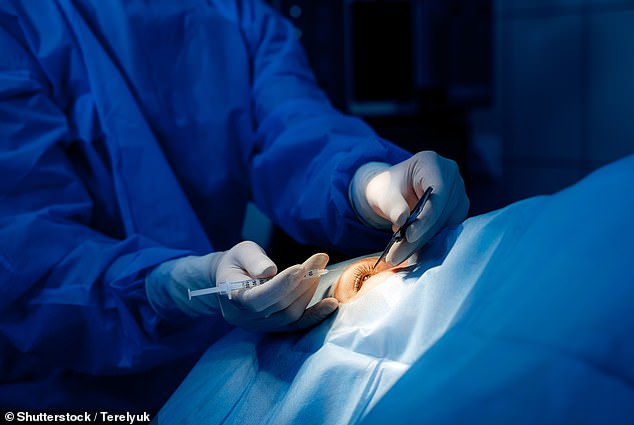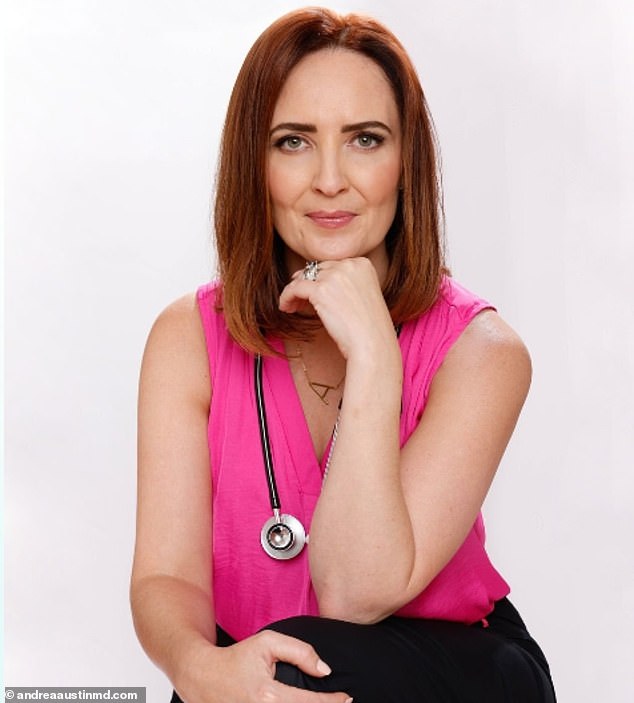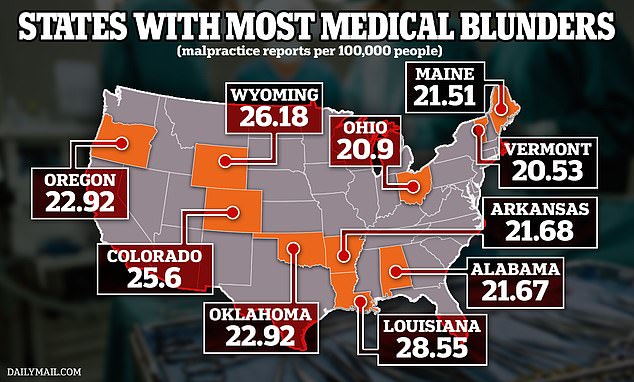A urologist removes a kidney from the wrong patient. A nurse incorrectly administers a paralyzing drug that causes the patient’s death. A neurosurgeon operates on the wrong side of a woman’s brain.
Medical errors like these harm 1.2 million Americans and cause the deaths of about 251,000 patients each year.
Both on and off the record, doctors whose specialties range from general practice to emergency medicine told DailyMail.com about dangerous medical accidents that occur within hospital walls and that providers are inclined or encouraged to cover up.
Among the most common: prescribing the wrong medication and dispensing a drug to the wrong patient, which cause approximately 8,000 patient deaths each year.
Errors in obtaining appropriate laboratory tests, as well as filing and clerical errors such as incorrect labeling of results or diagnoses, are also commonly seen in hospitals and private practices, perhaps more so than patients realize.
The map above shows the states that have faced the most medical malpractice lawsuits.
Dr Andrea Austin, an emergency physician in Southern California, told DailyMail.com: “Some of the errors I’ve seen are the wrong medications being prescribed and while the person ordering the medication is ultimately responsible, none of these errors happen in isolation. It’s a broader systems issue.”
‘Sometimes the wrong test is ordered… And depending on where we’re working, sometimes the amount of distractions and interruptions… It’s very common in the emergency department (to be) interrupted eight, ten times in an hour period when you’re trying to order high-risk medications and tests.
“This is a trap to potentially order the wrong test on the wrong patient or the wrong medication.”
A devastating case of medical error took the country by surprise in 2022 when former Vanderbilt Medical Center nurse RaDonda Vaught was found guilty of negligence and negligent homicide and sentenced to three years of supervised probation.
In December 2017, Ms Vaught was due to give her patient Charlene Murphey a dose of Versed, a sedative to calm her before entering a large MRI-like machine, but the 75-year-old was instead injected with vecuronium, an extremely potent paralysant.
By the time the error was detected, Mrs. Murphey was dead.
When Vanderbilt reported the death to the medical examiner.The error was not mentioned and the cause of death was ruled “natural.”
Ms. Vaught acknowledged her mistake, though she also called attention to the myriad of other factors that played a role in her deadly error, including the fact that she was also orienting a new nurse, which was a distraction, the new electronic records system had only been implemented seven weeks earlier in a very complicated rollout, and there were timing policies for administering medications, which made her actions hasty.
The case became a rallying cry for nurses, who argued that Prosecuting Vaught would have a chilling effect on the entire health care field.discouraging professionals from admitting mistakes for fear of losing their jobs or being sentenced to prison.
Linda Aiken, a professor of nursing and sociology at the University of Pennsylvania, said of the case: “One thing everyone agrees on is that it will have a dampening effect on reporting of errors or near misses, which then has a detrimental effect on safety.
‘The only way to really learn about errors in these complicated systems is for people to say, “Oh, I almost gave him the wrong medicine because….” Well, nobody’s going to say that now.’
Dr Drew Remignanti, a retired emergency physician from New Hampshire, told DailyMail.com about the time he misdiagnosed a mark on a patient’s cornea as a fingernail scratch from putting in contact lenses.
Corneal scratches are usually treated with antibiotic drops and heal relatively quickly.
But Dr. Remignanti had misdiagnosed the patient, who actually had a corneal ulcer.
A year later, Dr. Remignanti received notice that he was being sued for malpractice because he failed to detect the infection at the time, which later required the patient to undergo surgery with another doctor to replace part of his cornea with donor tissue.
Dr. Remignanti, who wrote about the confusion in his book The Healing ConnectionHe said: ‘This is an example of what is called confirmation bias, where you see what you expect to see… Even though the bias was round and regular, I was not willing to think beyond the first conclusion offered.
“I should have known better and been more careful in my assessment and decision-making.”
In another medical error, Dr. Ashish Jha, as an internist practicing at Harvard, once prescribed a drug to the wrong patient.whom he mistook for someone else.
He said: ‘They were two patients of mine with very similar names and I simply prescribed it to the wrong patient.
“I felt terrible, I felt incompetent, I felt a little ashamed. My first instinct was not just to fix the problem, but not to tell anyone.
“It’s clearly not the right thing to do, but we have to start by recognizing that it’s a very human response.”

Medical errors harm 1.2 million Americans and cause the deaths of about 251,000 patients each year (file photo)
Doctors have said they are often taught to hide mistakes because admitting them could lead to litigation from patients or their families.
But Dr Austin said this highlights how broken the system is. If mistakes are not recognised, the doctor who made them is unlikely to improve and more are likely to occur.
And because most medical errors often go unreported, the exact magnitude of the problem remains unknown.
Dr. Danielle Ofri, an internist at Bellevue Hospital in New York City, said: National Public Radio‘I don’t think we’ll ever know what number, in terms of cause of death, is due to medical error, but it’s not small.’
He added: “Near misses are the huge iceberg lurking beneath the surface where all future errors will occur. But we don’t know where they are, so we don’t know where to send our resources to fix them or make them less likely to happen.”
The largest study of adverse events is the Harvard Medical Practice Study, a review of more than 30,000 randomly selected patients discharged from 51 randomly selected hospitals in New York State in 1984.
The proportion of adverse events attributable to errors was 58 percent, and the proportion of adverse events due to negligence was 28 percent.
Although most patients who suffered these errors were disabled for less than six months, 14 percent resulted in death and three percent suffered injuries that left them permanently disabled.
Medication complications, such as allergic reactions, dispensing errors, among others, were the most common type of adverse event (19 percent), followed by wound infections (14 percent) and technical complications in surgery (13 percent), such as injuries sustained during an operation or bleeding during or after.
Injuries such as excessive bleeding during or after surgery, infection, and broken bones. It occurred in 3.7 percent of hospitalizations.
Not much other research has been published on the topic, but one A smaller 2023 review of records for 2,810 patients from Boston-area hospitals showed about 24 percent experienced at least one adverse event such as allergic reactions to medications or falls that put their health at risk.

Dr. Andrea Austin is an emergency physician based in Southern California. She told DailyMail.com that errors can be prevented if healthcare workers have the right support systems in place.
It is also not uncommon for doctors to misdiagnose patients, especially in stressful emergency departments.
A study published last year in the journal BMJ Quality and Safety Protocol It was found that 795,000 patients die or are permanently disabled each year due to misdiagnosis.
In addition to misdiagnoses, doctors may order the wrong tests or misfile their results, confuse patients, and lose or misinterpret test results.
Meanwhile, medication errors can occur. At any stage of the care process: ordering, dispensing, managing and monitoring.
Although most medication errors do not result in patient injury, those that do are most likely to occur at the prescribing (56 percent) and administration (34 percent) stages in the hospital setting and are most commonly intercepted during the prescribing phase.
Doctors often cite electronic health records (EHRs) — documentation that tracks a patient’s entire medical history, including vaccinations, surgeries and diagnoses — as a source of medical errors.
Dr. Austin said electronic medical records are often recorded using outdated technology. The most widely used systems were created in the 1980s, and many hospitals still use software from that era.
Doctors and nurses have long argued that EHRs take too long to complete and have a confusing and cluttered workflow that takes away valuable time from patient care.
Outdated EHR systems also lack built-in controls to monitor or alert on coding errors that could mean the wrong diagnosis or medication is entered.
It represents a broader systemic problem that hospitals have not devoted time or resources to address.
Dr Austin told DailyMail.com: “Today there should be no reason for systems not to check whether a patient has an allergy or alert a provider about a patient’s age and pregnancy status.”
He added: “To err is human. So whenever there are humans involved, there is the field of human factors that basically explains why a lot of these hairline errors happen. That’s why they are very predictable.”
“If we have a system that works and we basically support physicians with a working electronic medical record and with the proper checks and balances, then a lot of these errors could be prevented.”


